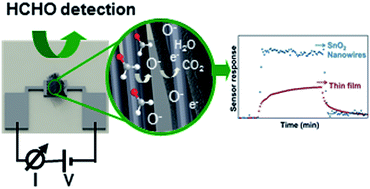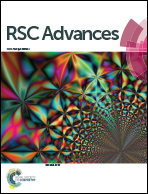Formaldehyde sensing mechanism of SnO2 nanowires grown on-chip by sputtering techniques†
Abstract
Tin dioxide nanowires have been grown by thermal oxidation of sputtered thin films by means of a VLS method. A tin sputtered layer catalyzed by gold nanoparticles acts as a material seed for the localized growth of NWs directly on gas sensor devices, avoiding the manipulation and transport of the nanowires to the electrodes. XRD and HRTEM analysis show that the nanowires crystallize in a rutile structure with a [100] preferential growth direction, and are single-crystalline with diameters lower than 50 nm. The response of nanowires to formaldehyde has been compared to thin film based sensors. A sensitivity of 0.10 ppm−1 is reported, twofold the sensitivity of the thin film, and short response and recovery times are measured (6 times shorter than thin films). The sensing mechanism proposed for the SnO2 NWs under formaldehyde exposure is explained by means of conduction measurements and FT-IR analysis. Oxygen species chemisorbed on the surface of each SnO2 nanowire produce a band bending, which generates a potential barrier (of 0.74 ± 0.02 eV at 300 °C) between the point contact of different nanowires. As evidenced by IR spectroscopy at 300 °C, electrons in the conduction band and in mono-ionized oxygen vacancies (at 0.33 eV below the bottom of the conduction band) are responsible for gas detection.


 Please wait while we load your content...
Please wait while we load your content...